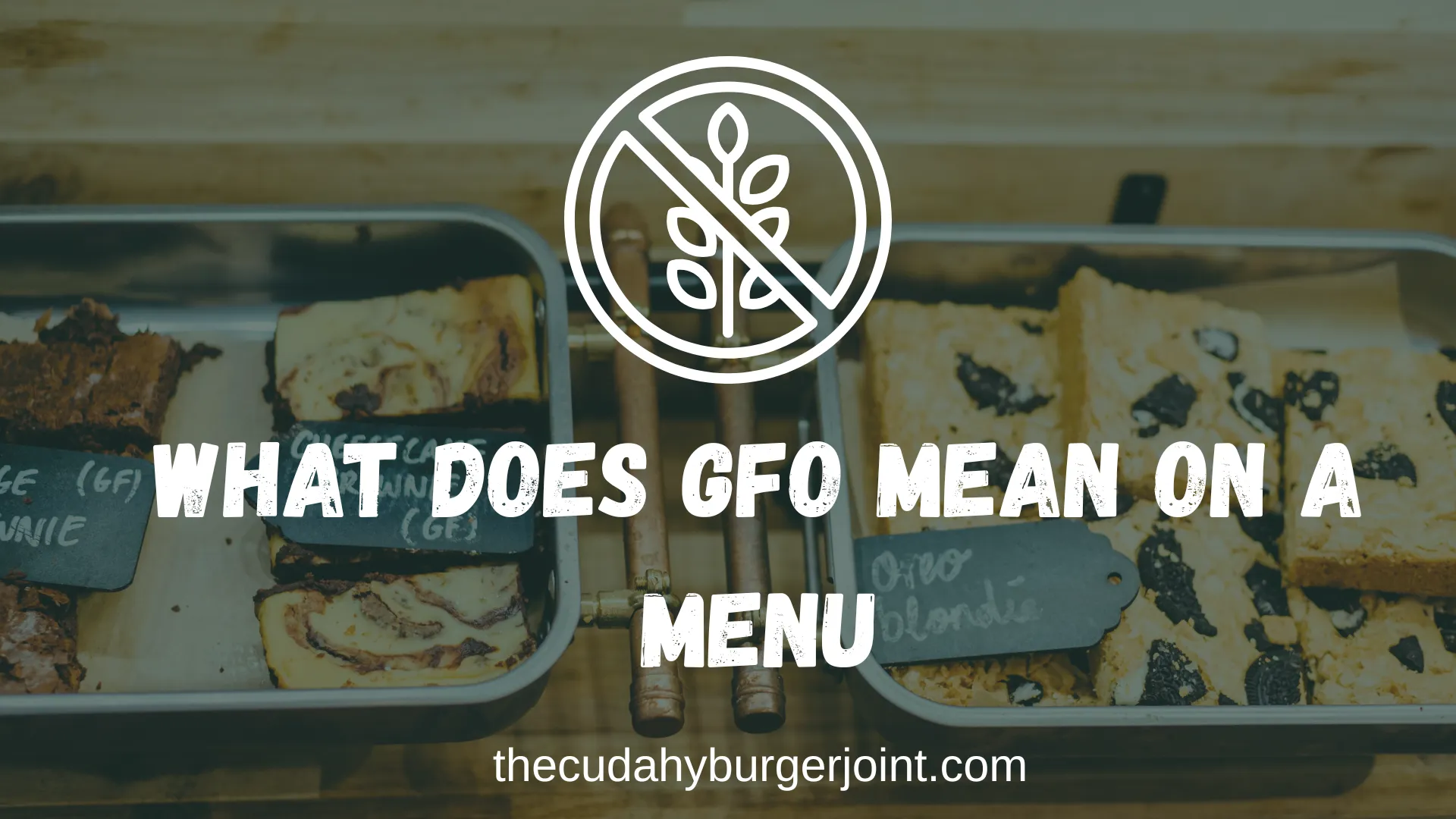What Does GFO Mean on a Menu? A Simple Guide
When you’re looking at a restaurant menu, you’ve probably seen all kinds of abbreviations—GF, V, VG, DF, and sometimes even GFO. And if you’ve ever asked yourself, “what does GFO mean on a menu?”, you’re not alone. These short codes can be confusing, especially if you just came in for a nice meal and suddenly feel like you’re reading a secret code book.
In this article, I’ll break it down in simple words. We’ll talk about what GFO really means, why restaurants use it, what kinds of dishes are labeled this way, and what it means for you when ordering. By the end, you’ll feel confident the next time you see GFO on a menu.
What Does GFO Mean on a Menu?
GFO stands for “Gluten-Free Option.”
This means that the dish you’re looking at is not automatically gluten-free, but the restaurant can prepare it in a gluten-free way if you ask.
For example:
- A burger on the menu might come with a regular wheat bun, but with GFO, you can request a gluten-free bun instead.
- Pasta dishes might normally be made with wheat noodles, but the chef might have gluten-free pasta available if you ask.
So, while “GF” means the dish is already 100% gluten-free, GFO gives you the choice to make it gluten-free with a small swap.
Why Do Restaurants Use GFO?
Restaurants know that more and more people are looking for gluten-free meals—whether it’s due to celiac disease, gluten sensitivity, or just lifestyle choices. Adding GFO to a menu helps them show customers:
- Flexibility – You’re not limited to just the dedicated gluten-free dishes.
- Customer Care – It shows the restaurant cares about dietary needs.
- Transparency – Customers immediately know which meals can be customized.
It’s also practical. Instead of creating a separate gluten-free menu, restaurants can mark GFO next to regular dishes, making it easier for both diners and staff.
Examples of GFO on a Menu
Let’s make this super clear with some everyday restaurant examples:
- Pizza (GFO) → The restaurant might offer a gluten-free crust option.
- Burger (GFO) → Swap the regular bun for a gluten-free bun or lettuce wrap.
- Pasta Alfredo (GFO) → Ask for gluten-free pasta noodles.
- Sandwich (GFO) → Choose gluten-free bread.
- Soup (GFO) → Sometimes thickened with flour, but the kitchen may have a gluten-free version.
Whenever you see GFO, think of it as: “This dish isn’t gluten-free yet, but it can be!”
Is GFO the Same as GF?
No, there’s a big difference:
- GF = Gluten-Free (the dish is already safe for gluten-free diets).
- GFO = Gluten-Free Option (you need to request changes).
This difference is important because if you’re very sensitive to gluten (like with celiac disease), you may want to double-check with your server. Even though a dish has a GFO label, cross-contamination can still happen in kitchens that handle regular wheat products.
Why Is Gluten-Free Important?
A quick refresher: gluten is a protein found in wheat, barley, and rye. While most people can eat it without issue, some cannot:
- People with celiac disease get very sick from gluten.
- Those with gluten sensitivity may feel bloated, tired, or have stomach issues.
- Some people just prefer to avoid gluten for health or diet reasons.
That’s why GF and GFO labeling has become so popular—it gives customers confidence and choice.
Tips for Ordering GFO at a Restaurant
So now that you know what it means, here are a few practical tips for using it:
- Always Ask First – Even if you see GFO, confirm with your server what exactly makes it gluten-free.
- Check for Cross-Contamination – Some kitchens use the same fryer oil or surfaces for gluten and gluten-free foods.
- Don’t Be Shy – Restaurants expect questions! If you need something swapped (bun, bread, pasta), just ask politely.
- Double-Check Ingredients – Sauces, soups, and dressings sometimes hide gluten.
Remember: GFO gives you the option, but it’s always better to confirm.
Is GFO More Expensive?
Sometimes, yes. Gluten-free bread, pasta, or pizza crusts usually cost restaurants more to buy. So they might add an extra $1–$3 for the gluten-free option.
For example:
- Regular burger: $10
- Burger (GFO with gluten-free bun): $11
Not always, but don’t be surprised if the bill is a tiny bit higher.
My Personal Experience with GFO
The first time I saw GFO on a menu, I honestly thought it was a typo. I remember looking at the pizza section and wondering, what on earth is GFO? After asking the server, I realized it meant gluten-free option, and since then, I’ve noticed it almost everywhere—especially in places like pizza chains, burger joints, and even fine-dining restaurants.
For me, it’s been super helpful because my friend is gluten-sensitive. Instead of skipping half the menu, she now knows which dishes can be tweaked for her. It’s a small detail that makes a big difference when dining out.
Related Terms You Might See on Menus
- GF – Gluten-Free
- DF – Dairy-Free
- V – Vegetarian
- VG – Vegan
- GFO – Gluten-Free Option
These little abbreviations are becoming the new language of restaurant menus. Knowing them saves time and prevents confusion.
Curious about other menu terms? Don’t miss my blog on What Does MP Mean on a Menu?, where I explain it in the same simple way.
Conclusion
Now you know! GFO on a menu means “Gluten-Free Option.” It tells you that the dish isn’t naturally gluten-free but can be adjusted with a simple swap—like a gluten-free bun, pasta, or crust.
Next time you’re at a restaurant and see GFO, you’ll know exactly what it means and how to order. And if you’re ever unsure, just ask your server—they’re there to help.
So the mystery is solved: GFO = more choice, more flexibility, and happier dining.

